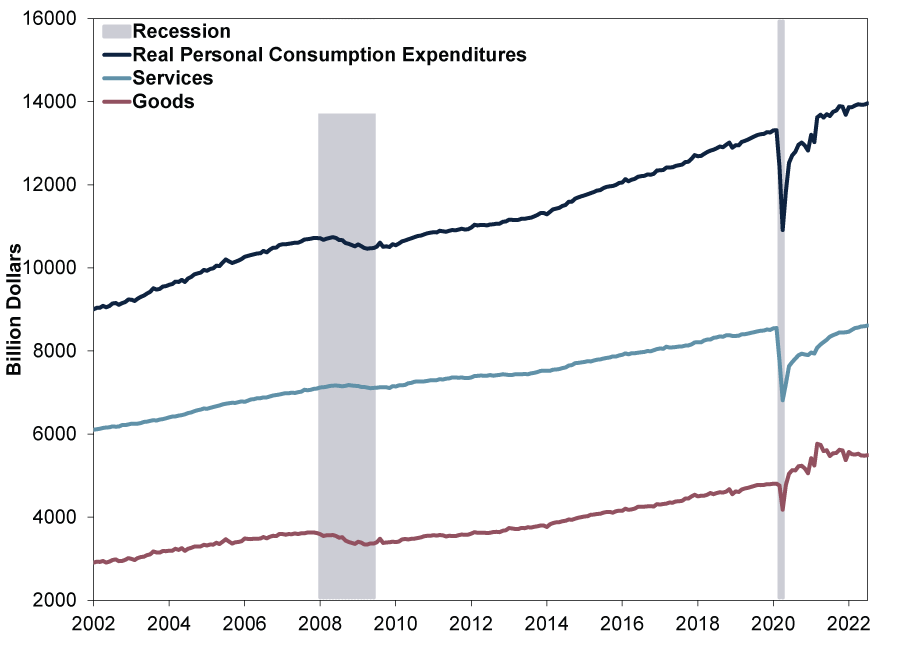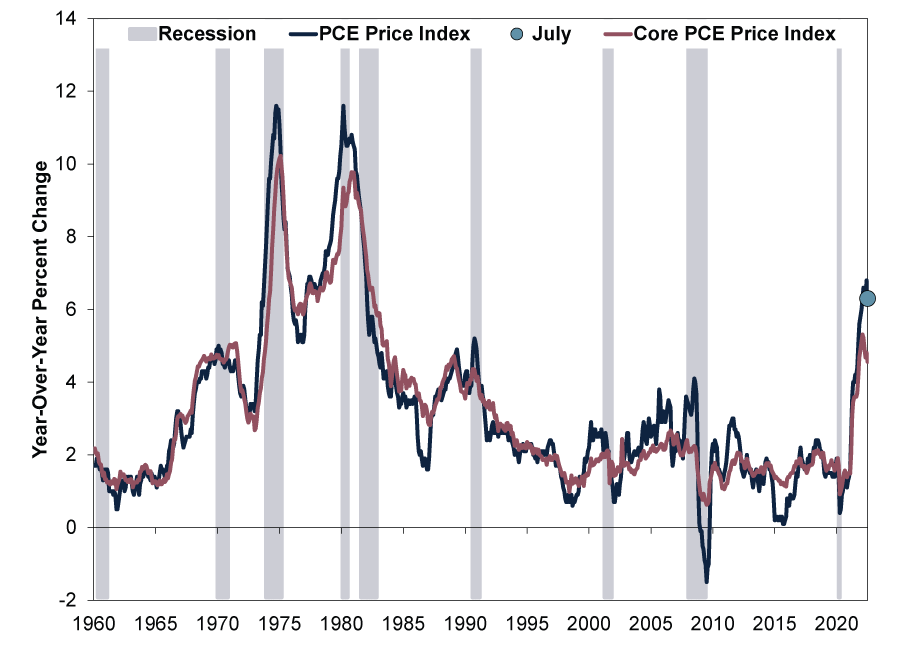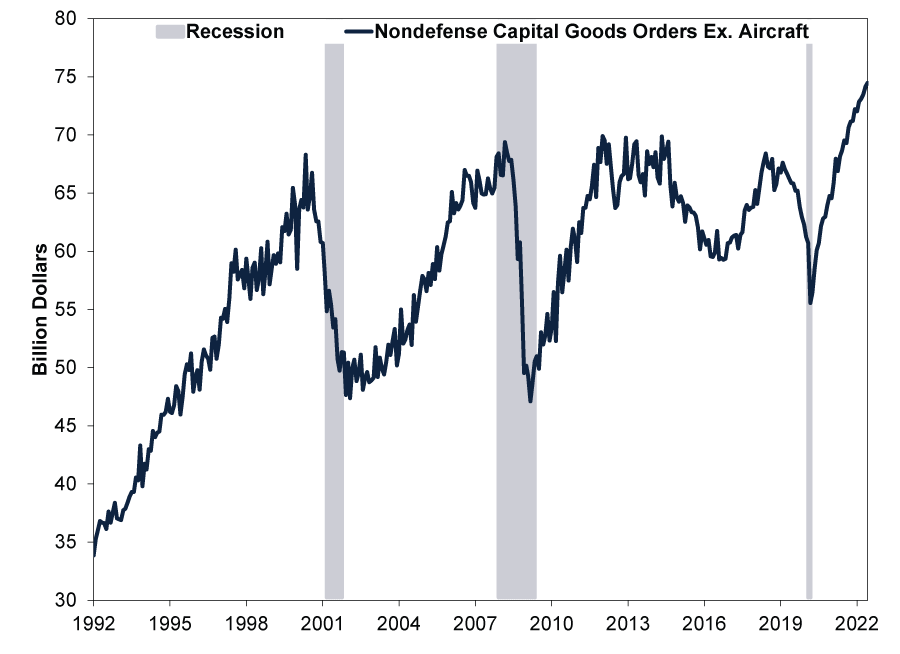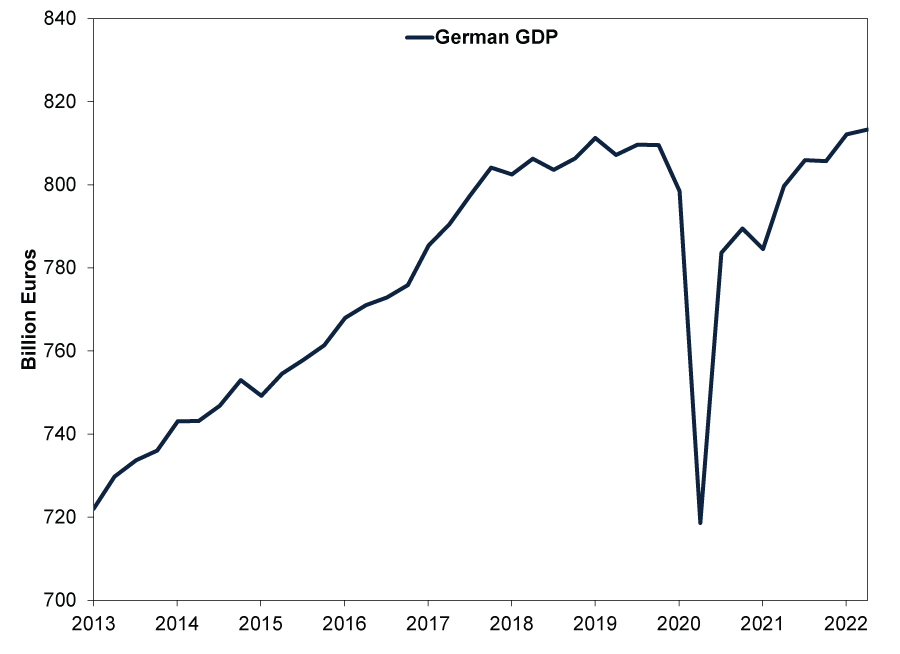Personal Wealth Management / Economics
An Economic Data Check-In
We think a look at recent data from the US and Germany suggests conditions aren’t as weak as feared.
Lately, we have seen economic data coming out a bit better than expected. Whilst a backward-looking glance won’t dictate where markets are headed, we think it helps lay down the baseline reality from which to gauge sentiment. Have a look at some of the higher-profile recent reports.
America’s July personal consumption expenditures (PCE) release last Friday showed inflation-adjusted consumption rising at Q3’s start and inflation (economy-wide price increases) moderating. Real PCE—aka consumer spending—rose 0.2% m/m.[i] (Exhibit 1) In our estimation, that isn’t gangbusters, but it is right on its monthly average rate since 2002.[ii] To us, that indicates underlying demand is holding up despite inflation.
Exhibit 1: American Consumer Spending Growth Slow, but Still Upward
Source: US Federal Reserve Bank of St. Louis, as of 1/9/2022. US real PCE and its goods and services components, January 2002 – July 2022. Recession shading uses US National Bureau of Economic Research (NBER) business cycle dates. NBER defines recession as a significant decline in economic activity that is spread across the economy and that lasts more than a few months.
Beneath the bonnet, real PCE’s services and goods components show some normalisation. With US services consumption (light blue) back at pre-pandemic levels this spring, growth has also levelled off—it rose 0.2% m/m in July and has averaged that since March.[iii] After surging during lockdowns, goods spending (maroon) has flattened since spring 2021 as restrictions relaxed. However, the divergence paused as July spending on goods grew 0.2% m/m, too.[iv] Whilst spending on non-durable goods declined, spending on durable goods (meaning, goods designed to last three or more years) jumped for the second month running, rising 1.5% m/m.[v] It could be that as petrol prices fell, people had more bandwidth to buy bigger-ticket items.
The PCE report also indicated US price pressures may be starting to ease some. Based on our observations, Americans seem well aware petrol prices aren’t quite as crushing anymore, perhaps affording them a bit more room on their grocery bills, if not for their utilities. We think the numbers reflect these perceptions. July’s PCE price index ticked -0.1% m/m lower, decelerating to 6.3% y/y from June’s 6.8% 40-year high. (Exhibit 2) This was largely due to declining petrol prices, as PCE’s energy price index fell -4.8% m/m.[vi] Food prices continued to rise, though, up 1.3% m/m.[vii] Excluding food and energy, the core PCE price index ticked up 0.1% m/m and decelerated more modestly to 4.6% y/y from 4.8%.[viii] That said, the latest reading is notably below February’s 5.3% y/y rate.[ix]
Exhibit 2: US Inflation Starting to Moderate?
Source: US Federal Reserve Bank of St. Louis, as of 1/9/2022. US PCE price index and its core measure excluding food and energy, January 1960 – July 2022.
Another report out last week: US factory orders for durable goods, which were flat in July owing to a big drop in military aircraft orders, which can be quite lumpy month to month.[x] One way we have found economists try to rectify this: Strip out volatile components—using such a pared-down measure, nondefense capital goods orders excluding aircraft rose 0.4% m/m.[xi] (Exhibit 3)
Exhibit 3: US Core Durable Goods Orders Making New Highs
Source: US Federal Reserve Bank of St. Louis, as of 1/9/2022. Nondefense capital goods orders excluding aircraft, February 1992 – July 2022. Some economists we follow consider this a core measure of US durable goods orders.
Note that these data aren’t inflation-adjusted, so the rise may just reflect higher prices—not more actual stuff. Furthermore, we think America’s producer price index (PPI) reflects prices for this investment, and PPI inflation presently exceeds the US consumer price index’s and PCE’s inflation rates.[xii] But also, durable goods aren’t a full look at business investment. As compiled in America’s gross domestic product (GDP, a government-produced measure of economic output), durable goods—vehicles, machinery and equipment—make up only 45% of US firms’ capital expenditures.[xiii] They spend almost as much—42%—on software, research and development and other intangible intellectual property.[xiv] (The rest is structures, e.g., buildings, factories, warehouses, drilling platforms, refineries and other storage facilities.) But in our view, durable goods orders do show higher interest rates aren’t deterring spending on new equipment. We don’t see any deep and widespread business retrenchment in evidence here.
Looking across the North Sea, Germany recently revised up its Q2 GDP growth to 0.1% q/q from flat in its initial estimate. (Exhibit 4) So after Q1’s recovery back to Q4 2019’s pre-pandemic level, the German economy has expanded further. Although Q2 is well in the rear-view mirror, the new release quantifies what was only general colour commentary from Germany’s Federal Statistics Office before. Namely, real household consumption rose 1.0% q/q, accelerating from Q1’s 0.8%.[xv] This occurred after most COVID restrictions eased, so the bump is relatively unsurprising, in our view. Reopening boosts as pent-up demand unleashes have been a consistent pattern worldwide, according to our research. Somewhat offsetting this: business investment, which fell -1.3% q/q.[xvi] This all came from commercial construction’s -3.4% q/q decline.[xvii] German firms’ machinery and equipment spending rose 1.1% q/q for its third quarterly rise.[xviii]
Exhibit 4: Despite Challenges, German GDP Continued to Grow Through Q2
Source: FactSet, as of 1/9/2022. German GDP, Q1 2013 – Q2 2022.
We also found trade’s contribution notable, as Q2 German exports rose 0.3% q/q despite exports to Russia taking a big hit.[xix] Surging energy imports to offset the loss of Russian gas flows detracted, as did German tourism outside the country. But overall, Germany managed ongoing GDP growth. Even amidst high inflation and energy costs, we think economic conditions are turning up better than many commentators we follow warn.
Now, perhaps it is unsurprising, as commentators these days commonly couch any positive sign as soon to morph negatively—a phenomenon we call the pessimism of disbelief—that stories we read interpret these better-than-expected data as a sign monetary policy institutions will tighten policy much more from here, knocking stocks. That has seemingly stirred sentiment recently, in our view, although we think the conclusions are questionable. For one, we find it impossible to know how monetary policymakers are viewing the data, or even which data they think are important. Two, we don’t think there is any pre-set relationship between monetary policy and stocks, so even if more rate rises come, it wouldn’t be auto-bearish. That said, sentiment is viewing data through a dour lens, in our view, and that, historically, has been the foundation for a market recovery.
[i] Source: US Federal Reserve Bank of St. Louis, as of 1/9/2022.
[ii] Ibid.
[iii] Ibid.
[iv] Ibid.
[v] Source: US Bureau of Economic Analysis, as of 1/9/2022.
[vi] Ibid.
[vii] Ibid.
[viii] Ibid.
[ix] Ibid.
[x] Source: US Census Bureau, as of 1/9/2022.
[xi] Source: US Federal Reserve Bank of St. Louis, as of 1/9/2022.
[xii] Source: US Bureau of Labor Statistics, 1/9/2022.
[xiii] See note v.
[xiv] Ibid.
[xv] Source: FactSet, as of 1/9/2022.
[xvi] Ibid.
[xvii] Ibid.
[xviii] Ibid.
[xix] Ibid.
Get a weekly roundup of our market insights.
Sign up for our weekly e-mail newsletter.

See Our Investment Guides
The world of investing can seem like a giant maze. Fisher Investments UK has developed several informational and educational guides tackling a variety of investing topics.









